初一英语语法回顾(三)---一般现在时 疑问句和否定句练习
- 格式:doc
- 大小:101.66 KB
- 文档页数:3
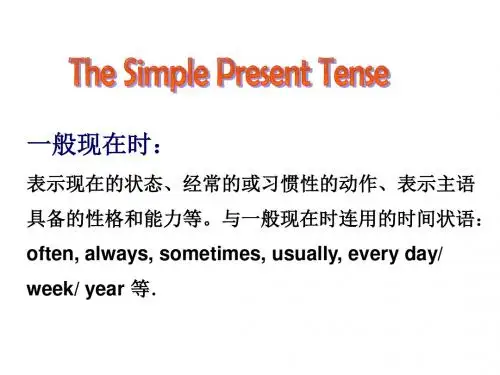
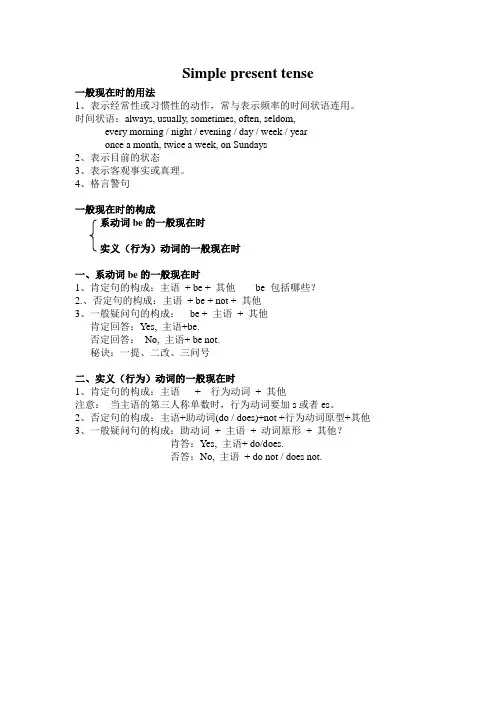
Simple present tense
一般现在时的用法
1、表示经常性或习惯性的动作,常与表示频率的时间状语连用。
时间状语:always, usually, sometimes, often, seldom,
every morning / night / evening / day / week / year
once a month, twice a week, on Sundays
2、表示目前的状态
3、表示客观事实或真理。
4、格言警句
一般现在时的构成
系动词be的一般现在时
实义(行为)动词的一般现在时
一、系动词be的一般现在时
1、肯定句的构成:主语+ be + 其他be 包括哪些?
2.、否定句的构成:主语+ be + not + 其他
3、一般疑问句的构成:be + 主语+ 其他
肯定回答:Yes, 主语+be.
否定回答:No, 主语+ be not.
秘诀:一提、二改、三问号
二、实义(行为)动词的一般现在时
1、肯定句的构成:主语+ 行为动词+ 其他
注意:当主语的第三人称单数时,行为动词要加s或者es。
2、否定句的构成:主语+助动词(do / does)+not +行为动词原型+其他
3、一般疑问句的构成:助动词+ 主语+ 动词原形+ 其他?
肯答:Yes, 主语+ do/does.
否答:No, 主语+ do not / does not.。

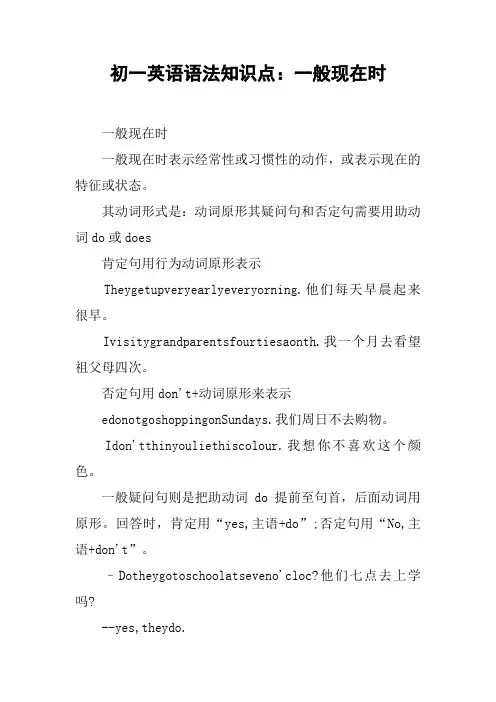
初一英语语法知识点:一般现在时一般现在时一般现在时表示经常性或习惯性的动作,或表示现在的特征或状态。
其动词形式是:动词原形其疑问句和否定句需要用助动词do或does肯定句用行为动词原形表示Theygetupveryearlyeveryorning.他们每天早晨起来很早。
Ivisitygrandparentsfourtiesaonth.我一个月去看望祖父母四次。
否定句用don't+动词原形来表示edonotgoshoppingonSundays.我们周日不去购物。
Idon'tthinyouliethiscolour.我想你不喜欢这个颜色。
一般疑问句则是把助动词do提前至句首,后面动词用原形。
回答时,肯定用“yes,主语+do”;否定句用“No,主语+don't”。
–Dotheygotoschoolatseveno'cloc?他们七点去上学吗?--yes,theydo.--Doyouliethissirt?你喜欢这条裙子吗?--No,Idon't.不,我不喜欢。
一般现在时用来表示经常的或习惯性的动作,常与以下的时间状语连用:often经常,alays总是,soeties有时,usually通常,everyday/ee每天/周等。
Heusuallygoestoschoolbybie.通常他骑车上学。
Ivisitygrandparentseveryee.我每个星期都去看祖父母。
Sheisalayslateforclass.她总是上课迟到。
yparentsandIsoetiesgoouttoeat.我和父母有时出去吃饭。
Itoftenrainshere.这儿常常下雨。
主语为第三人称单数时的一般现在时一般现在时态,当主语为第三人称单数时,谓语动词也要是第三人称单数,后要加-s或-es。
Heliesreadingatnight.他喜欢夜里读书。
Sheusuallygoestoschoolbybie.她平时骑车上学。
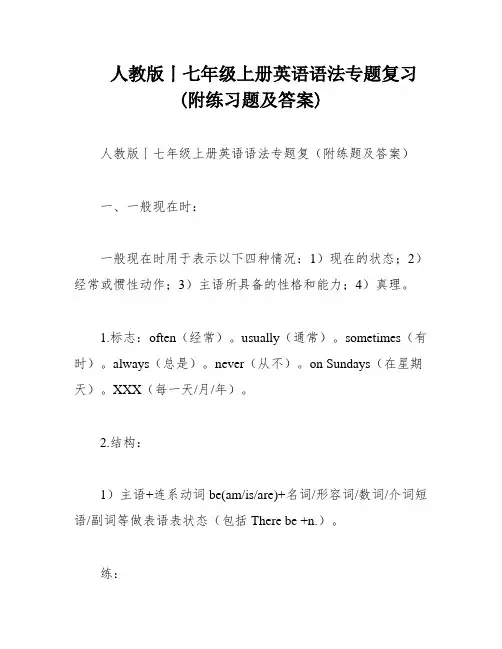
人教版丨七年级上册英语语法专题复习(附练习题及答案)人教版丨七年级上册英语语法专题复(附练题及答案)一、一般现在时:一般现在时用于表示以下四种情况:1)现在的状态;2)经常或惯性动作;3)主语所具备的性格和能力;4)真理。
1.标志:often(经常)。
usually(通常)。
sometimes(有时)。
always(总是)。
never(从不)。
on Sundays(在星期天)。
XXX(每一天/月/年)。
2.结构:1)主语+连系动词be(am/is/are)+名词/形容词/数词/介词短语/副词等做表语表状态(包括There be +n.)。
练:1.I am a student。
My name is Tom.2.Where are my shoes。
They are here.3.Who is the girl with long straight hair。
I think she is Kate.4.You and I are not in Class Six.5.XXX。
Yes。
there is.6.XXX。
No。
they aren't.2)主语(非第三人称单数)+行为动词原形+其他(用助动词do帮助构成否定句、一般疑问句和特殊疑问)。
3)主语(第三人称单数)+行为动词的第三人称单数+其他(用助动词does帮助构成否定句、一般疑问句和特殊疑问句)。
行为动词第三人称单数加-s的形式:1.-s2.辅音+y: study-studies3.以s,x,ch,sh结尾: watch-watches。
XXX4.特殊: have-has。
do-does。
go-goes。
练:1.His parents watch TV every night.肯定句:1.XXX.否定句:2.His parents do not watch TV every night.n: My brother does not do homework every day。
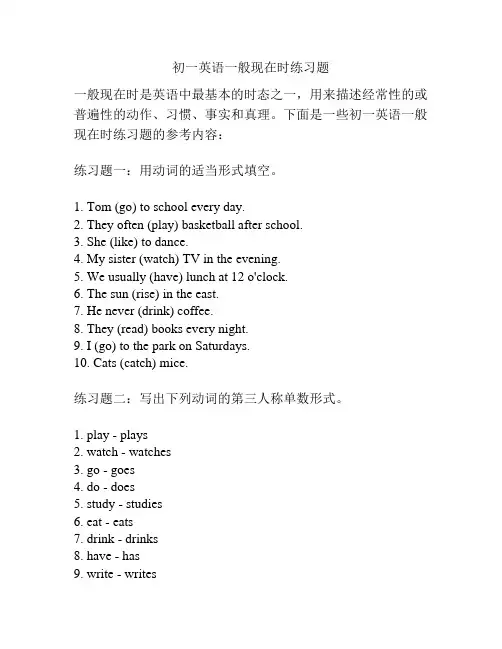
初一英语一般现在时练习题一般现在时是英语中最基本的时态之一,用来描述经常性的或普遍性的动作、习惯、事实和真理。
下面是一些初一英语一般现在时练习题的参考内容:练习题一:用动词的适当形式填空。
1. Tom (go) to school every day.2. They often (play) basketball after school.3. She (like) to dance.4. My sister (watch) TV in the evening.5. We usually (have) lunch at 12 o'clock.6. The sun (rise) in the east.7. He never (drink) coffee.8. They (read) books every night.9. I (go) to the park on Saturdays.10. Cats (catch) mice.练习题二:写出下列动词的第三人称单数形式。
1. play - plays2. watch - watches3. go - goes4. do - does5. study - studies6. eat - eats7. drink - drinks8. have - has9. write - writes10. read - reads练习题三:改写句子,使用动词的适当形式。
1. My brother watches TV every evening. (变为否定句)--> My brother doesn't watch TV every evening.2. They go swimming on Sundays. (改为一般疑问句)--> Do they go swimming on Sundays?3. She often helps her mother with the housework. (变为一般疑问句)--> Does she often help her mother with the housework?4. We usually eat breakfast at 7 o'clock. (改为否定句)--> We don't usually eat breakfast at 7 o'clock.5. He has lunch at school every day. (改为复数形式)--> They have lunch at school every day.练习题四:根据图片,完成句子。
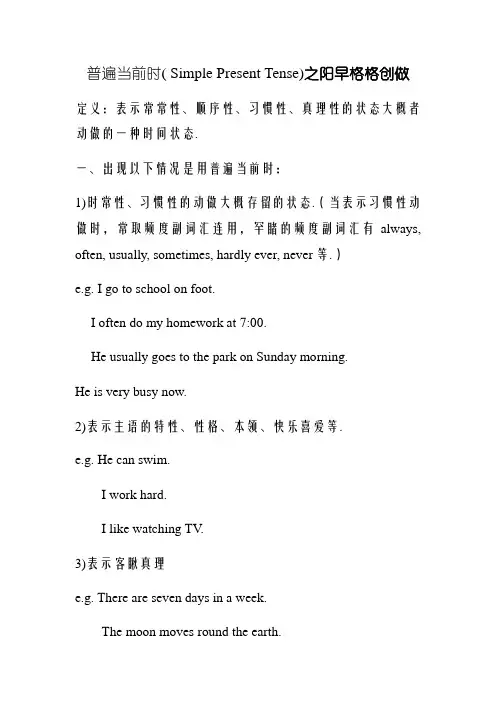
普遍当前时( Simple Present Tense)之阳早格格创做 定义:表示常常性、顺序性、习惯性、真理性的状态大概者动做的一种时间状态.
一、出现以下情况是用普遍当前时: 1)时常性、习惯性的动做大概存留的状态.(当表示习惯性动做时,常取频度副词汇连用,罕睹的频度副词汇有 always, often, usually, sometimes, hardly ever, never等.)
e.g. I go to school on foot. I often do my homework at 7:00. He usually goes to the park on Sunday morning. He is very busy now. 2)表示主语的特性、性格、本领、快乐喜爱等. e.g. He can swim. I work hard. I like watching TV. 3)表示客瞅真理 e.g. There are seven days in a week. The moon moves round the earth. 二、普遍当前时的句式变更: 1、动词汇be 通联动词汇be是表示谓语闭系的动词汇,它的后里必须加表语(常常为名词汇、形容词汇大概介词汇短语).正在普遍当前时中,be动词汇有三种形式:
肯定式 可定式 I am... You are... He/She/It is... We/You/They are... I am not... You are not... He/She/It is not... We/You/They are not... 疑问式战大略问语 Am I...? Yes, you are. No, you are not. Are we...? Yes, we/you are. No, we/you are not. Are you...? Yes, I am. No, I am not. Are you...? Yes, we are. No, we are not. Is he/she/it...? Yes, he/she/it is. No, he/she/it is not. Are they...? Yes, they are. No, they are not. 肯定式 可定式 其余 I’m= I am You’re= you are He’s=he is Aren’t= are not Isn’t= is not That’s= that is What’s= what is Who’s= who is
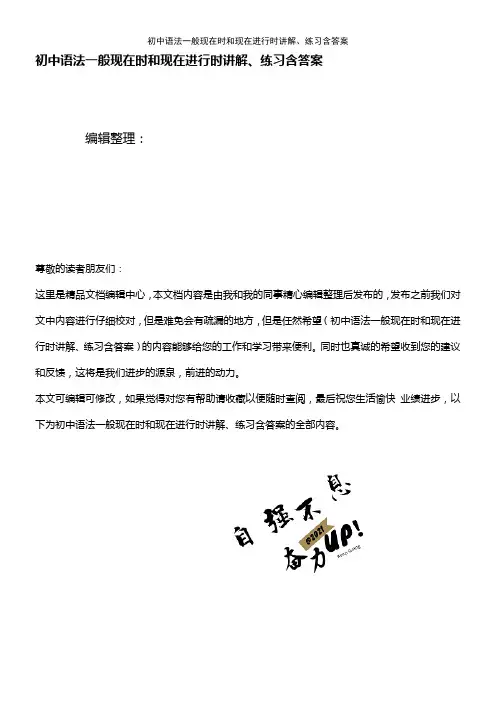
初中语法一般现在时和现在进行时讲解、练习含答案编辑整理:尊敬的读者朋友们:这里是精品文档编辑中心,本文档内容是由我和我的同事精心编辑整理后发布的,发布之前我们对文中内容进行仔细校对,但是难免会有疏漏的地方,但是任然希望(初中语法一般现在时和现在进行时讲解、练习含答案)的内容能够给您的工作和学习带来便利。
同时也真诚的希望收到您的建议和反馈,这将是我们进步的源泉,前进的动力。
本文可编辑可修改,如果觉得对您有帮助请收藏以便随时查阅,最后祝您生活愉快业绩进步,以下为初中语法一般现在时和现在进行时讲解、练习含答案的全部内容。
一般现在时:一、定义与讲解:一般现在时表示经常或习惯性的动作或一般性事实。
,也可表示现在的状态或主语具备的性格和能力。
通常与副词every day(每天),always(总是),usually(通常),often(经常)sometimes(有时),等时间状语连用。
例:(1)表示事物或人物的特征、状态.The sky is blue.天空是蓝色的。
Mary's father is an English teacher。
玛丽的爸爸是一名英语老师。
(2)表示经常性或习惯性的动作.I get up at six every day。
我每天六点起床。
She plays sports every day。
她每天都做运动。
(3)表示客观现实.The table has four legs。
桌子有四条腿。
There are 50 students in my class. 我们班有50个学生。
(4)表示客观真理,科学原理,自然现象,等客观事实或格言谚语等. The sun rises in the east every day.太阳每天从东方升起。
The earth goes around the sun.地球绕着太阳转.(5)表示平日的喜好.I like bananas. We don’t like vegetables.He likes ice cream。
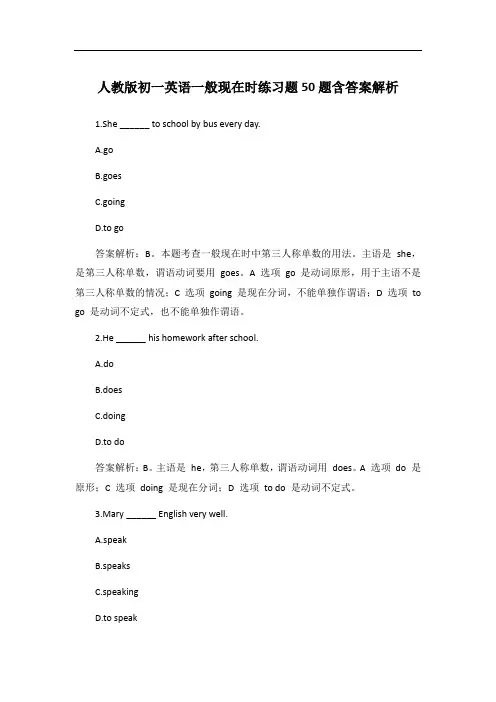
人教版初一英语一般现在时练习题50题含答案解析1.She ______ to school by bus every day.A.goB.goesC.goingD.to go答案解析:B。
本题考查一般现在时中第三人称单数的用法。
主语是she,是第三人称单数,谓语动词要用goes。
A 选项go 是动词原形,用于主语不是第三人称单数的情况;C 选项going 是现在分词,不能单独作谓语;D 选项to go 是动词不定式,也不能单独作谓语。
2.He ______ his homework after school.A.doB.doesC.doingD.to do答案解析:B。
主语是he,第三人称单数,谓语动词用does。
A 选项do 是原形;C 选项doing 是现在分词;D 选项to do 是动词不定式。
3.Mary ______ English very well.A.speakB.speaksC.speakingD.to speak答案解析:B。
Mary 是第三人称单数,谓语动词speak 要变成speaks。
A 选项是原形;C 选项speaking 是现在分词;D 选项to speak 是动词不定式。
4.The dog ______ very fast.A.runB.runsC.runningD.to run答案解析:B。
The dog 是第三人称单数,动词run 变成runs。
A 选项是原形;C 选项running 是现在分词;D 选项to run 是动词不定式。
5.My father ______ to work by car.A.goB.goesC.goingD.to go答案解析:B。
My father 是第三人称单数,谓语动词用goes。
A 选项是原形;C 选项going 是现在分词;D 选项to go 是动词不定式。
6.She ______ a book every week.A.readB.readsC.readingD.to read答案解析:B。
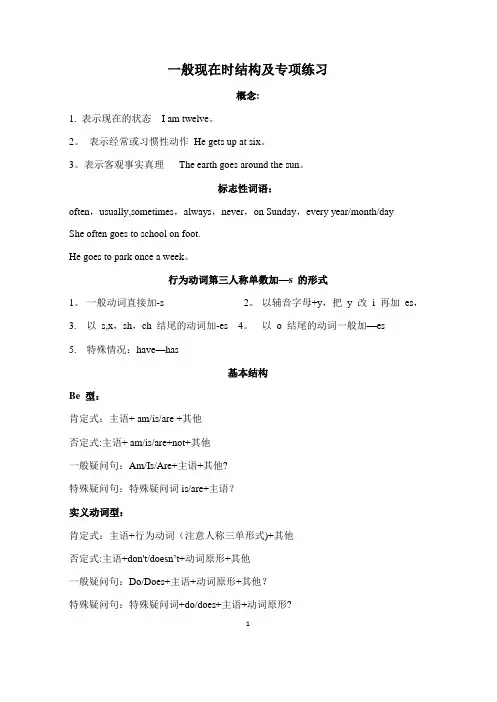
一般现在时结构及专项练习概念:1. 表示现在的状态I am twelve。
2。
表示经常或习惯性动作He gets up at six。
3。
表示客观事实真理The earth goes around the sun。
标志性词语:often,usually,sometimes,always,never,on Sunday,every year/month/dayShe often goes to school on foot.He goes to park once a week。
行为动词第三人称单数加—s 的形式1。
一般动词直接加-s 2。
以辅音字母+y,把y 改i 再加es,3. 以s,x,sh,ch 结尾的动词加-es 4。
以o 结尾的动词一般加—es5. 特殊情况:have—has基本结构Be 型:肯定式:主语+ am/is/are +其他否定式:主语+ am/is/are+not+其他一般疑问句:Am/Is/Are+主语+其他?特殊疑问句:特殊疑问词is/are+主语?实义动词型:肯定式:主语+行为动词(注意人称三单形式)+其他否定式:主语+don't/doesn’t+动词原形+其他一般疑问句:Do/Does+主语+动词原形+其他?特殊疑问句:特殊疑问词+do/does+主语+动词原形?1写出下列动词的第三人称形式wash: watch:study:finish:go:snow:carry:stop:see:drive:let:teach:keep:join:put:do:drink:enjoy play:begin:take:run: fly:talk:stay:look:think:carry: fix:单项选择1。
There _____ an English film at the cinema now.A:is B:are C:am D:be2. The picture nic e. A:look B:looks C:looked D:be look3. He sits down and soon asleep.A:fall B:falling C:falled D:falls4。
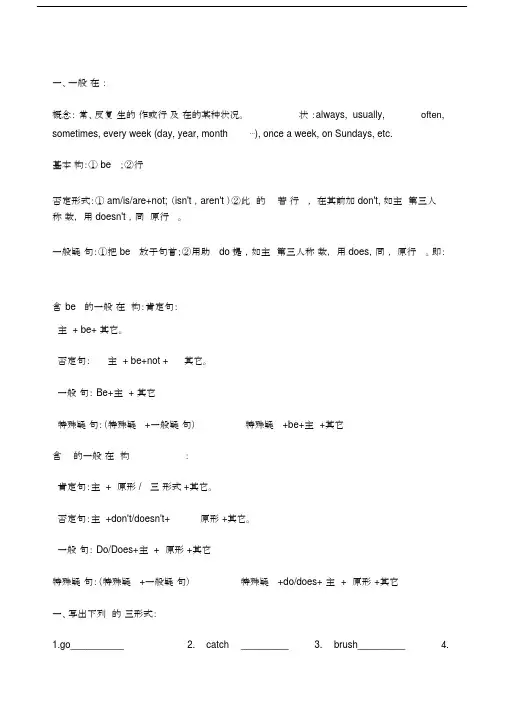
一、一般在:概念:常、反复生的作或行及在的某种状况。
状:always, usually,often, sometimes, every week (day, year, month⋯), once a week, on Sundays, etc.基本构:① be ;②行否定形式:① am/is/are+not; (isn't ,aren't )②此的若行,在其前加 don't, 如主第三人称数,用 doesn't ,同原行。
一般疑句:①把 be 放于句首;②用助 do 提,如主第三人称数,用does,同,原行。
即:含be 的一般在构:肯定句:主 + be+ 其它。
否定句:主 + be+not +其它。
一般句: Be+主 + 其它特殊疑句:(特殊疑 +一般疑句)特殊疑+be+主+其它含的一般在构:肯定句:主 +原形 / 三形式 +其它。
否定句:主 +don't/doesn't+原形+其它。
一般句: Do/Does+主 +原形 +其它特殊疑句:(特殊疑 +一般疑句)特殊疑+do/does+主+原形+其它一、写出下列的三形式:1.go__________2. catch _________3. brush_________4.wash___________5. do________6. like________7. have___________8.watch ___________9. drink ___________10.fly___________11.say___________12.learn ___________13.eat___________ 14.read___________ 15.sing___________ brush________二、选择填空:( )1. I ________to school at 7:00 in the morning. A. go B. goingC. goes( )2. They _______books every day in the library. A.reads B. readC. reading( )3.The monkey________eating bananas very much. A.like B.likes C. liking( )4. My father ________to read newspaper after supper every day.A.likeB. likesC. liking( )5. I like watching TV, but my mother _________like it. A. don ’t B. doesn’t C. does( )6. ____________ your father drink milk every day?A.DoB.AreC.Does把下列句子变成否定句1.I like cooking.2.My friends like playing soccer.3.Lily and Lucy read comic books every day.4.I drink tea in the morning.5.The bird likes singing.6.May and David climb mountains every week.7.My aunt likes to go fishing.8.They speak English every day.9.She is always a good student..把下列句子变成一般疑问句及做肯定及否定回答。
七年级一般现在时讲解及练习(精)一、一般现在时的定义:(1)表示平时经常发生的事情(2)表示现在的状态如果问同学们你们每天都在干什么?你们会回答:如果问你喜欢英语吗?你会回答:这时我们会用到一般现在时二、将下列主语和谓语动词划出来例子: I do my homework in the evening.1.We have dinner at school.2.She likes pears.3.I go to school at half past six.4.He always jeans and trainers.5.Daming's uncle likes reading and he reads a lot of novels and magazines.总结:当主语为第三人称单数时,谓语动词会发生怎样的变化?三、将下列动词变为第三人称单数形式eat get tay havedo go like playbuy watch make finishlive read listen drinkswim run变法有以下几种情况:(一)一般动词(二)以s,x,sh,ch,辅音字母+o结尾的动词(三)以y结尾的动词有两种情况 A 以元音字母+y结尾的 B 以辅音字母+y结尾的(四)特殊动词have练习:将下列三个句子做主语替换练习(将主语分别替换为 he, she , my sister, Tom, they , my parents ...)1.I like reading.2 We speak Chinese.3 She goes to school every day.四、将下列句子变为一般疑问句及否定句并观察其变法I often get up at six o'clock.Do you often get up at six o'clock ?I don't often get up at six o'clock.1.We play football in the afternoon.2.I usually send emails to my friend.3.They4.Tom and Tony have breakfast at home.5.I live in China.总结:当主语为第一、二人称或第三人称复数时,一般疑问句变法:否定句变法五、将下列句子变为一般疑问句及否定句并观察其变法She wears silk shirts.Does she wear silk shirts? She doesn't wear silk shirts.1 He usually listens to music.2 She gets up early.3 My brother likes maths.4 The boy runs in the morning.总结:当主语为第三人称单数时,一般疑问句变法为:否定句变法为:综合练习:一、用所给动词的正确形式填空1 The camel __________( eat ) grass.2 They ________( live) in the desert.3 I ________( like ) playing basketball.4 My aunt usually _________( make) a cake.5 She often _________( buy ) presents for her family.6 Linda __________( sing ).7 We _________( have ) a great time.8 My friends ____________( like ) birthdays.9 My aunt and uncle usually _____________( remember ) our birthdays.二、用don't和doesn't完成句子1 Daming and Lingling ____________( not have ) lunch at home.2 Daming _________( not drink ) Coke.3 They ________________(not read ) magazines.5 Betty _______________( not watch ) TV in the evening.三、分别用do和does写出一般疑问句并回答you , go to bed, at half past ten ?Do you go to bed at half past ten ? Yes, I do. / No, I don't.2 she , like, English5 your mother , watch TV, in the evening?6 your teacher , speak English ?。
学生姓名: 年级: 初一升除二 第 三课 任课教师:夏丽林 一般现在时
基础达标型 一、选择填空 ( )1.—What’s your name? —My name Anna. A. am B. is C. are D. be ( )2.— you in Row 1? —No, I’m not. I’m in Row 2. A. Is B. Are C. Am D. Be ( )3.—How old she? —She is ten. A. are B. is C. / D. am ( )4. She a key in her hand. A. is B. was C. has D. have ( )5. Can he a horse? A. fly B. ride C. go D. sit ( )6.—Can you see a kite over there? —Yes, . A. I do B. I can’t C. I can D. I am ( )7. her brother know the teacher? A. Do B. Is C. Does D. Are ( )8. Sandy’s a model plane in her room. A. find B. make C. makes D. making ( )9. I all your names. A. do know B. don’t know C. doesn’t D. knows ( )10. We lessons on Sunday. A. don’t have B. didn’t have a C. has no D. hasn’t no ( )11. Kitty and Amy want to watch TV? A. Does B. Are C. Do D. Is ( )12. I like Mr Gao. a good doctor. A. He are B. He is C. he is D. He am ( )13. He often dinner at his grandparents’ home. A. eat B. have C. has D. cook ( )14.— I borrow your ruler? —Sorry, you can’t. I’m using now. A. Can B. Do C. Does D. Did ( )15.—What does she Tony? —Nothing. A. says to B. say to C. tell to D. tells ( )16. Do you know he English every morning? A. read B. reading C. is reading D. reads ( )17. Does Amy music? A. likes listening to B. like listening C. like listening to D. likes to listen to ( )18. Tommy wants to know what Millie a school day. A. do on B. does in C. do in D. does in ( )19.— sandy and her sister like walking together? —Yes, do. A. Do; they B. Does; they C. Can; they D. Do; we ( )20. the woman English? A. Does; speak B. Does; teach C. Does; teaches D. A and B 二、从括号中选词填空,完成句子 1. I have a soccer ball.(doesn’t, don’t) 2. This pen like a pencil. (look, looks) 3. All my friends really great.(have, are) 4.—Why he like penguins? —Because they’re very interesting.(do, would) 5. It never in Australia in December.(snows, snowed) 6. Bridge Street good place to have fun.(is, may) 7. Sometimes Linda to school by bus, sometimes by bike.(goes, is going) 8. My neighbour the piano. She usually the piano at about this time. 9. Does she English in the school?(studies, study) 10. My sister s not a doctor. She work in this hospital.(didn’t, doesn’t) 疑问句与否定句 基础达标型 一、选择填空 ( ) 1. She playing the guitar. A. are B. isn’t C. am not D. were ( )2. We watching TV when someone knocked at the door. A. aren’t B. are C. weren’t D. be ( )3. I at school when she went to school. A. am not B. didn’t C. don’t be D. wasn’t ( )4. This kind of TV set made in Japan. It was made in America. A. wasn’t B. isn’t C. was D. is ( )5.— you go to the movie? —Yes, I did. A. Were B. Do C. Did D. Are ( )6.—Can you help me cleaning the room? —Sorry, I . A. can B. do C. don’t D. can’t ( )7. I go home next Sunday. We are going to help an old man. A. Won’t B. am not C. will D. don’t ( )8. There isn’t milk in the bottle. A. some B. any C. many D. a ( )9. I go to bed until eleven lat night. A. / B. won’t C. didn’t D. wasn’t ( )10. Mr Brown a teacher. He is a doctor. A. isn’t B. may C. can be D. doesn’t ( )11.— you please pass me a pen? —Yes, please. A. Did B. Will C. Shall D. Are ( )12.— wrong with your kite? —It’s broken. A. What’s B. How is C. What D. How ( )13. be late, will you? A. Isn’t B. Doesn’t C. Don’t D. Didn’t ( )14. They an old black and white TV set now. A. didn’t have B. have not C. are having D. doesn’t have ( )15.—Where’s my key? Do you know? —Sorry, I . A. am not know B. not know C. don’t know D. know not 二、从方框中选择单词或短语,完成对话 Not at all, Don’t eat, may not, can’t, No, How often, How long 1.—Would you like to have another cake? — ,thanks, I’m full. 2.—May I come in, please? —Sorry, you . 3.—Let me help you. —Thank you. — . 4.—Is there anything wrong with me? —Nothing much. too much meat, or you’ll be much too fat. 5.— do you clean the goldfish’s tank? —Only once a week. Passage 3 Do you know the word “brunch”? In many countries, many people have lunch-late breakfast with early lunch. People usually have lunch between 10:00 a.m. and 2:00 p.m on Sunday because they like to get up late after a week’s hard work or want to enjoy brunch with their parents. This is an interesting way of eating for many families. Today, brunch has become most popular in big hotels. To make it like both breakfast and lunch, people have a lot of dishes. You can often see the food on the table, meat, eggs, fruit, vegetables, orange juice, tea and potatoes. 1. Brunch is A. breakfast B. lunch C. late breakfast with early lunch D. between 8:00 and 10:00 2. Why do many people have brunch now? . A. Because brunch is nice. B. Because no one like breakfast. C. Because they have no time to have lunch. D. Because they like to get up late after a week’s hard work or want to enjoy brunch with their parents. 3. Brunch has become most popular in . A. factories B. big hotels C. schools D. shops 4. What can’t we see on the table when people have brunch? . A. Tea B. Potatoes C. Fruit. D. Eggs. 5. Which of the following is wrong? . A. Brunch is an interesting way of eating for many families. B. Brunch has become most popular in every hotel. C. Brunch is between 10:00 and 2:00. D. People have a lot of dishes for their brunch.